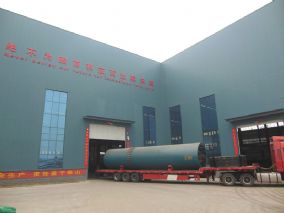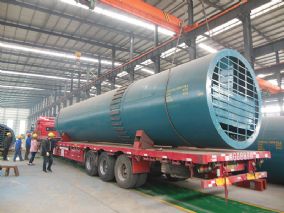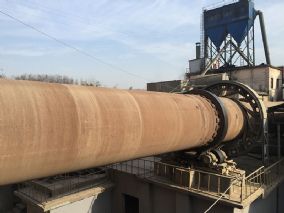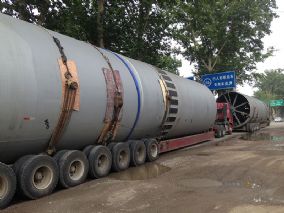Cement rotary kiln
date:2019-07-30 13:45:26 views:1159

Cement rotary kiln is the main equipment of cement clinker dry and wet production line. Rotary kilns are widely used in metallurgy, chemical industry, building refractories, environmental protection and other industries. The rotary kiln is composed of cylinder, supporting device, supporting device with baffle wheel, transmission device, movable kiln head, sealing device of kiln tail, coal injection pipe device, etc. The kiln body of the rotary kiln is inclined to a certain level. The whole kiln body is supported by a supporting wheel device, and there is a wheel-retaining device to control the movement of the kiln body up and down. In addition to the main drive, the transmission system is also equipped with an auxiliary drive device which can make the kiln body rotate when the source of the main power is broken and prevent the kiln body from bending and deformation. The kiln head and the kiln tail are sealed. The device adopts advanced technology to ensure the reliability of the seal.
Working Principle of Cement Rotary Kiln:
Cement rotary kiln operates at high temperature with heavy load and alternating slow speed. The maintenance of accessories and the level of thermal system control are related to the safety and efficiency of rotary kiln operation. Maintenance of transmission device focuses on lubrication, running state, dynamic detection of equipment and meshing accuracy of big and small gears. The installation accuracy of supporting device determines whether rotary kiln can operate safely and reliably. In operation, attention should be paid to reasonable control of load distribution of each gear, the arrangement of supporting wheel and the up and down pressure of hydraulic gear. Time, force of supporting wheel, clearance between wheel belt and cushion plate. The quality of sealing device directly affects the thermal system and operation cost of rotary kiln. Strengthen the daily maintenance data collation and analysis of rotary kiln is conducive to the management of equipment.
Cement rotary kiln structure:
The rotary kiln is composed of cylinder, supporting device, supporting device with baffle wheel, transmission device, movable kiln head, sealing device of kiln tail, coal injection pipe device, etc. The kiln body of the rotary kiln is inclined to a certain level. The whole kiln body is supported by a supporting wheel device, and there is a wheel-retaining device to control the movement of the kiln body up and down. In addition to the main drive, the transmission system is also equipped with an auxiliary drive device which can make the kiln body rotate when the source of the main power is broken and prevent the kiln body from bending and deformation. The kiln head and the kiln tail are sealed. The device adopts advanced technology to ensure the reliability of the seal.
Cement rotary kiln uses:
In addition to burning cement clinker, cement rotary kiln is also used for burning clay, limestone and slag drying. In refractory production, rotary kiln is used for burning raw materials to stabilize its size, increase its strength and reprocess. In nonferrous and ferrous metallurgy, iron, aluminium, copper, zinc, tin, nickel, tungsten, chromium and files are sintered and roasted in rotary kiln. For example, aluminium hydroxide is roasted to alumina in aluminium production; pellets are produced for blast furnace ironmaking with aluminium hydroxide in ironmaking; iron ore is directly reduced by SL/RN method and Krupp method abroad; tin and lead are extracted by chlorination volatilization roasting method. In the process of mineral processing, the lean iron ore is magnetized by rotary kiln, so that the original weak magnetism of the ore is changed to strong magnetism, which is beneficial to magnetic separation. In chemical industry, baking soda, phosphate fertilizer and barium sulfide are produced in rotary kiln. This method has the advantages of low energy consumption, less electricity consumption, no use of sulphuric acid and the availability of medium and low grade phosphate rock, and is quickly popularized.
In addition, in the aspect of environmental protection, cement rotary kiln is used to incinerate hazardous wastes and garbage, which not only reduces the amount of waste and makes it harmless, but also uses waste as fuel, saves coal powder and realizes the resource utilization of waste.
水泥回转窑技术参数:
| 序号 | 规格 m | 基本参数 | 主电动机 | 挡轮形式 | 支承形式 | 设备重量 t | ||
| 转速 r/min | 斜度 % | 产量 t/h | 功率 kW | |||||
| 1 | Φ3.2×50 | 0.674~3.37 | 3.5 | 1000 | 160 | 液压 | 滑动 | 252.4 |
| 2 | Φ3.5×52.5 | 0.6~3.6 | 3.5 | 1500 | 180 | 366.5 | ||
| 3 | Φ4×56 | 0.35~3.5 | 3.5 | 2000 | 250 | 489 | ||
| 4 | Φ4×60 | 0.396~3.96 | 3.5 | 2500 | 315 | 523 | ||
| 5 | Φ4.3×64 | 0.4~3.96 | 3.5 | 3200 | 420 | 606.69 | ||
| 6 | Φ4.8×72 | 0.39~3.96 | 3.5 | 5000 | 630 | 853.3 | ||
| 7 | Φ4.8×74 | 0.35~4 | 4 | 5000 | 630 | 864 | ||
| 8 | Φ5.2×61 | 0.38~3.79 | 3.5 | 5500 | 800 | 859 | ||
| 9 | Φ5×80 | max3.5 | 4 | 6000 | 800 | |||
| 10 | Φ5.6×87 | max4.23 | 4 | 8000 | 800 | 1201 | ||
- prev:Rotary kiln
- NEXT:Ceramic Sand Rotary Kiln






